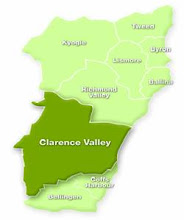
Cartoon found at Google Images
This blog is open to any who wish to comment on Australian society, the state of the environment or political shenanigans at Federal, State and Local Government level.

A brief history 29 January 2009 to 15 March 2010:
Super clinic site
Super clinic for Grafton 29 January 2009
Provider chosen to run GP super clinic 15 July 2009
Super Clinic site a secret 17 November 2009
Site announced for new GP super clinic 13 January 2010
No methadone for super clinic 23 February 2010
GP says support for local doctors needed 24 February 2010
Sth Grafton calls for medical clinic 11 March 2010
Last Friday NBN Television reported on Clarence Valley Council's attempt to turn back the coastal tides:
"The Clarence Valley Council is undertaking erosion control measures on the banks of the Clarence River at Iluka.Thursday 18 March 2010
The Mural Hall, Parliament House, Canberra, 8.30am – 12.30pm
Universities Australia is the peak body of all Australia's universities and is committed to engaging with Parliament on issues of great national significance, and to informing social, political and commercial responses to those issues.
The UA Forum on Climate Change will focus both on the scientific evidence, and the certainties and uncertainties of that evidence, as well as the challenges of communicating the science and of bridging scientific knowledge and public policy.
The program will comprise three sessions each with a series of brief presentations covering:
Session 1: Climate change in Australia today – the evidence
Session 2: Australian research that reveals the future of climate change – certainties and uncertainties
Session 3: Responding to climate change: the social and economic impact
The speakers will include research leaders in climate science and the impacts of climate change including: Nathan Bindoff, Roger Jones, Amanda Lynch, Roger Stone, Snow Barlow, Marie Keatley, Janette Lindesay, Ove Hoegh-Guldberg, and John Quiggin
Some of the issues that will be covered are:
For more information visit www.scienceinpublic.com.au/blog/ua
For more information and to register please contact Niall Byrne, Science in Public Ph: 03 9398 1416, Mobile: 0417 131 977
Email: niall@scienceinpublic.com.au
Just as the Rudd Government has two bills before Parliament which would a) allow the Australian Taxation Office to hand secret taxpayer information to other government agencies to "prevent or lessen" a serious threat to public health or safety and b) establish a national database containing every citizen's personal residential and health information in the face of serious continuing doubts concerning data security and function creep, as well as intending to sanction the non-consensual handling of personal information to facilitate research in the public interest, not just for medical and health research, the Australian Law Reform Commission releases a series of recommendations which advise government to weaken criminal sanctions in certain circumstances for improperly disclosing information.
In the face of evidence that Medicare, Centrelink, the Tax Office and certain other government agencies all have a long history of spying on individual client records and that theft and sale of health information is not unknown internationally - do we really need to see criminal sanctions watered down for any form of unlawful information sharing?
Of course the principal motivation for establishing this national database is not just installing an e-Health program, it also appears to be a desire to create a backdoor citizen identification scheme similar to those proposed in relation to the Australia Card and Access Card, so this haphazard approach to the security of a citizen's personal digital information is perhaps par for the course.
ALRC media release on 11 March 2010:
The final report of the Australian Law Reform Commission's comprehensive review of Commonwealth secrecy laws, Secrecy Laws and Open Government in Australia (ALRC Report 112) was tabled in federal Parliament today. The report is the product of a 15-month inquiry and makes 61 recommendations for reform. It sets out a new and principled framework designed to reinforce open and accountable government while ensuring adequate protection for Commonwealth information that should legitimately be kept confidential......
Prof Croucher stated that a key focus of the ALRC report was to "wind back" the use of criminal sanctions, for the unauthorised disclosure of information, including the repeal of s 70 of the Crimes Act 1914, which has attracted consistent criticism over the years. "Criminal sanctions should only be imposed where the unauthorised release of information has caused, or is likely or intended to cause, harm to identified public interests."
ALRC Report 112 Secrecy Laws and Open Government in Australia



Hi! My name is Boy. I'm a male bi-coloured tabby cat. Ever since I discovered that Malcolm Turnbull's dogs were allowed to blog, I have been pestering Clarencegirl to allow me a small space on North Coast Voices.
A false flag musing: I have noticed one particular voice on Facebook which is Pollyanna-positive on the subject of the Port of Yamba becoming a designated cruise ship destination. What this gentleman doesn’t disclose is that, as a principal of Middle Star Pty Ltd, he could be thought to have a potential pecuniary interest due to the fact that this corporation (which has had an office in Grafton since 2012) provides consultancy services and tourism business development services.
A religion & local government musing: On 11 October 2017 Clarence Valley Council has the Church of Jesus Christ Development Fund Inc in Sutherland Local Court No. 6 for a small claims hearing. It would appear that there may be a little issue in rendering unto Caesar. On 19 September 2017 an ordained minister of a religion (which was named by the Royal Commission into Institutional Responses to Child Sexual Abuse in relation to 40 instances of historical child sexual abuse on the NSW North Coast) read the Opening Prayer at Council’s ordinary monthly meeting. Earlier in the year an ordained minister (from a church network alleged to have supported an overseas orphanage closed because of child abuse claims in 2013) read the Opening Prayer and an ordained minister (belonging to yet another church network accused of ignoring child sexual abuse in the US and racism in South Africa) read the Opening Prayer at yet another ordinary monthly meeting. Nice one councillors - you are covering yourselves with glory!
An investigative musing: Newcastle Herald, 12 August 2017: The state’s corruption watchdog has been asked to investigate the finances of the Awabakal Aboriginal Local Land Council, less than 12 months after the troubled organisation was placed into administration by the state government. The Newcastle Herald understands accounting firm PKF Lawler made the decision to refer the land council to the Independent Commission Against Corruption after discovering a number of irregularities during an audit of its financial statements. The results of the audit were recently presented to a meeting of Awabakal members. Administrator Terry Lawler did not respond when contacted by the Herald and a PKF Lawler spokesperson said it was unable to comment on the matter. Given the intricate web of company relationships that existed with at least one former board member it is not outside the realms of possibility that, if ICAC accepts this referral, then United Land Councils Limited (registered New Zealand) and United First Peoples Syndications Pty Ltd(registered Australia) might be interviewed. North Coast Voices readers will remember that on 15 August 2015 representatives of these two companied gave evidence before NSW Legislative Council General Purpose Standing Committee No. 6 INQUIRY INTO CROWN LAND. This evidence included advocating for a Yamba mega port.
A Nationals musing: Word around the traps is that NSW Nats MP for Clarence Chris Gulaptis has been talking up the notion of cruise ships visiting the Clarence River estuary. Fair dinkum! That man can be guaranteed to run with any bad idea put to him. I'm sure one or more cruise ships moored in the main navigation channel on a regular basis for one, two or three days is something other regular river users will really welcome. *pause for appreciation of irony* The draft of the smallest of the smaller cruise vessels is 3 metres and it would only stay safely afloat in that channel. Even the Yamba-Iluka ferry has been known to get momentarily stuck in silt/sand from time to time in Yamba Bay and even a very small cruise ship wouldn't be able to safely enter and exit Iluka Bay. You can bet your bottom dollar operators of cruise lines would soon be calling for dredging at the approach to the river mouth - and you know how well that goes down with the local residents.
A local councils musing: Which Northern Rivers council is on a low-key NSW Office of Local Government watch list courtesy of feet dragging by a past general manager?
A serial pest musing: I'm sure the Clarence Valley was thrilled to find that a well-known fantasist is active once again in the wee small hours of the morning treading a well-worn path of accusations involving police, local business owners and others.
An investigative musing: Which NSW North Coast council is batting to have the longest running code of conduct complaint investigation on record?
A fun fact musing: An estimated 24,000 whales migrated along the NSW coastline in 2016 according to the NSW National Parks and Wildlife Service and the migration period is getting longer.
A which bank? musing: Despite a net profit last year of $9,227 million the Commonwealth Bank still insists on paying below Centrelink deeming rates interest on money held in Pensioner Security Accounts. One local wag says he’s waiting for the first bill from the bank charging him for the privilege of keeping his pension dollars at that bank.
A Daily Examiner musing: Just when you thought this newspaper could sink no lower under News Corp management, it continues to give column space to Andrew Bolt.
A thought to ponder musing: In case of bushfire or flood - do you have an emergency evacuation plan for the family pet?
An adoption musing: Every week on the NSW North Coast a number of cats and dogs find themselves without a home. If you want to do your bit and give one bundle of joy a new family, contact Happy Paws on 0419 404 766 or your local council pound.